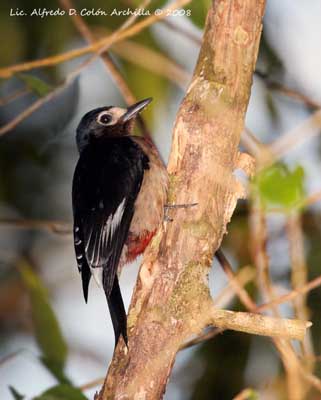
Puerto Rican Woodpecker
Melanerpes portoricensis
Piciforme Order – Picidae Family
BIOMETRICS:
Length: 23-27 cm; Weight: 56-72 g
DESCRIPTION:
Puerto Rican Woodpecker is small, and endemic to Puerto Rico.

Adult male has glossy blue-black upperparts. Rump is white, from lower back to upper tail coverts. Tail is glossy blue-black too, with sometimes tipped white outer feathers. Flight feathers are brownish-black, glossy blue on edges.
On the underparts, breast is bright red until down central belly. The blue-black colours of the neck extend to the breast sides, sometimes crossing the entire breast. Sides and flanks are pale buffy-brown. Under wing is brown, with black and white coverts. Undertail is pale brown.
On the black head, the male has white forehead and lores, with buffy wash on forehead. Chin, throat and malar area are bright red.
Long, blackish bill is relatively broad at base, and slightly chisel-shaped at tip. Eyes are dark brown surrounded by narrow, feathered, whitish eye-ring. Legs and feet are grey.
Female is smaller than male. She also has shorter bill. Chin, throat and malar area are mostly brown. She has less red on belly which is paler than in male.
Juvenile is duller, with less red on underparts. Young male can show few red feather tips on crown. It reaches its sexual maturity in the first year of its life.
VOICE: SOUNDS BY XENO-CANTO
Puerto Rican Woodpecker utters wide variety of sounds. The most common increases in volume and speed “wek, wek, wek-wek-wek-wek”. It also gives rolling sounds “gurrr-gurrr”, and loud series of “wicka” notes.
It performs weak and infrequent drums.
HABITAT:
Puerto Rican Woodpecker lives in wooded areas, in lower mountain forests, mangrove-swamps, coconut and shaded coffee plantations, palm tree groves, parks and gardens.
RANGE:
Puerto Rican Woodpecker is endemic and resident in Puerto Rico where it is common in the main island, and much rarer in Vieques Island.

BEHAVIOUR:
Puerto Rican Woodpecker forages on trunks and branches, singly, in pairs or in small family groups. It searches for larvae, wood-boring insects and others.
Male forages low or at mid-level in trees, using mainly pecking and probing. Its chisel-like bill and its barbed sticky tongue allow it to get food from bark and holes.
Female feeds higher than male, gleaning more than foraging, with her shorter bill.
Puerto Rican Woodpecker can eat occasionally frogs and lizards, but also fruits and berries.
Courtship and aggressive displays of woodpeckers are relatively similar. Feathers of crown and nape are erected, head extended and bill forwards the opponent or its mate. The tail is spread.
Male may engage swinging movements of head and body. The bird performs bowing while it calls loudly. Male can also perform aerial displays, a fluttering flight accompanied by squeaky calls.
FLIGHT:
Puerto Rican Woodpecker performs distinctive undulating flight, a kind of wavy flight, with several flaps of wings followed by pause, and flaps again.

REPRODUCTION:
Puerto Rican Woodpecker starts to build the nest in January. Male uses its bill and excavates the cavity in dead stump, high in tree. The entrance is in hard live wood. Then, tunnel is excavated and finally, the nest-chamber is dug out in softer wood. The birds have to peck and tear-off pieces of wood. Woodpeckers collect wood chips with the bill, and remove them from the hole, tossing their head out of the entrance.
Nest-chamber floor is often covered by wood chips.
Female lays 1 to 6 white eggs, usually 4, in April-May. Incubation and time at nest are unknown.
Chicks are fed equally by both male and female. Young are fed for two weeks more after fledging, and they remain in family group for longer period.

DIET:
Puerto Rican Woodpecker feeds mainly on wood-boring insects, beetle larvae, ants, grasshoppers and bugs. It can sometimes take frogs and lizards, but also seeds and fruits from palms, trees and other vegetation.
PROTECTION/THREATS/ STATUS:
Puerto Rican Woodpecker is a restricted range species, common and widespread in Puerto Rico, and rare in Vieques Island.
Fr: Pic de Porto Rico
All : Scharlachbrustspecht
Esp : Carpintero Puertorriqueño
Ital : Picchio di Portorico
Nd : Puerto Rico-specht
Photographs by Alfredo Colón
Puerto Rico Wildlife
Sources:
HANDBOOK OF THE BIRDS OF THE WORLD Vol. 7 by Josep del Hoyo-Andrew Elliott-Jordi Sargatal – Lynx Edicions – ISBN: 8487334377
Wikipedia (Wikipedia, The Free Encyclopedia)